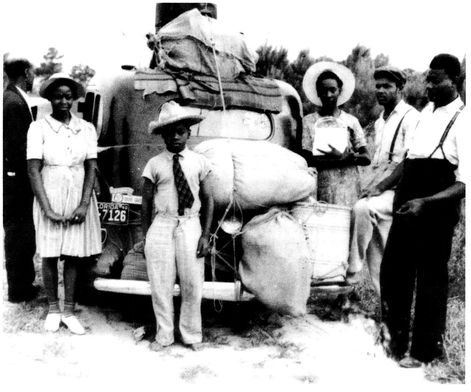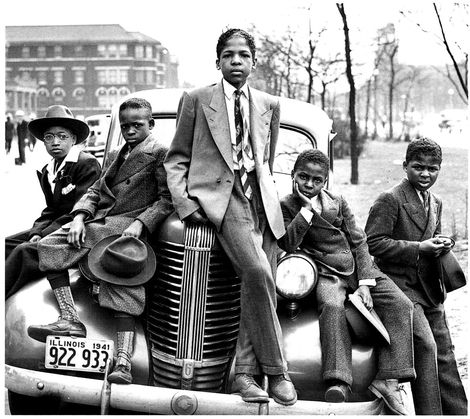“I’d rather be in prison in Detroit than to be free in the South.”
Lowndes County, Alabama, to Detroit, Michigan, 1924
LET ME OFF AT CHICAGO
Vernon Jarrett, a Chicago journalist, remembered a game he played as a boy with his friends in rural Tennessee. “We would dream all the time about things being better,” he said. “We’d get on the swing on a rope with a big car tire hanging on it from a tree. Someone would play conductor, and we’d call off the great cities, like: ‘Memphis. Who’s getting off at Memphis?’ Someone would answer, ‘I’m not getting off:’ ‘Nashville?’ ‘I’m not getting off:’ ‘Indianapolis?’ ‘I’m not getting off.’ ‘Detroit? St. Louis?’ ‘No. Let me off at Chicago … That’s where I want to be.’”
A million African Americans left the South for northern cities between 1915 and 1930 in what has been called the Great Migration. A second, even bigger wave started in the 1940s, when the invention of a mechanical cotton picker put southern field hands out of work. At the beginning of the twentieth century, African Americans were the most rural of Americans. By the end they were the most urban. Seventeen-year-old Charles Denby joined the migration when he left his Alabama plantation for Detroit in 1924.
Charles Denby, a tall, ambitious boy who shaved his head clean, was bound for Detroit. The main reason was simple: “We heard that you could make twenty-five or thirty dollars a week in a factory,” he later wrote. “After a few years I’d have several thousand dollars.” He planned to send money home to his parents, so they could “build a home like the white people had.”
There were other reasons, too. Except for his family and friends, Charles wasn’t leaving much behind in Alabama. He lived in a shack that looked out on forty acres of worn land where his father grew cotton. The whites he knew were cruel to him and his family. There was no future in sharecropping. His one-room school was “so full of cracks that a child could raise a plank in the floor and slip away without the teacher knowing.” The only subjects offered were reading and arithmetic; their teacher had only a sixth-grade education; Charles’s fifteen-year-old brother, Buddy, was still in third grade.
Charles was ten when some of the older boys on the plantation went off to Detroit and Cleveland and Chicago to work in factories during World War I. Good jobs were available to young black males at that time mainly because the whites who normally had them were fighting in Europe. Southern blacks, long used to hard work, suddenly looked so good to northern factory owners that they sent railroad cars south to haul them up north.
Many soon came back home to visit with money in their pockets and stories of better treatment. Charles listened keenly. “All the things we heard was like reading in the Bible,” he wrote, “milk and honey and pearly gates.”
A Florida family packed and ready to head north

Early in 1924, when Charles turned seventeen, a friend gave him the address of a Detroit boardinghouse and urged him to get a job in an automobile factory. Charles bought a ticket in Montgomery, Alabama, and boarded the “Negro car.” It was packed so tightly that people slept standing up. Just ahead were the roomier cars for whites.
They pulled away and darkness soon came. Charles hoped it would be light when they reached the Mason-Dixon Line, so he could finally see it. The Mason-Dixon Line was an imaginary border between the North and the South. Once it had separated the slave states from the free states, and now it separated states that had systems of racial segregation laws from those that didn’t. Like many southern blacks, Charles assumed the line was real. “I thought it would look like a row of trees with some kind of white mark like the mark in the middle of the highway,” he wrote. Just as the sun was rising, the train reached Covington, Kentucky, on the southern side of the Ohio River. Charles looked in vain for the line, until someone told him the bridge ahead over the Ohio was the Mason-Dixon Line.
FATHERS AND SONS
In 1917, an African-American preacher from Mississippi thought about the differences between his father and his son: “My father was born and brought up as a slave. He never knew anything else until after I was born. He was taught his place and was content to keep it. But when he brought me up he let some of the old customs slip by … and in bringing up my own son, I have let some more of the old customs slip by. He has been through the eighth grade; he reads easily. For a year I have been keeping him from going to Chicago; but he tells me this is his last crop; that in the fall he’s going. He says, ‘When a young white man talks rough to me, I can’t talk rough to him. You can stand that; I can’t. I have some education, and inside I have the feelings of a white man. I’m going.’”
THE CHICAGO DEFENDER
One reason that Chicago was the most popular destination for southern blacks was that so many read the Chicago Defender. The newspaper was founded in 1905 by Robert Abbott, who urged blacks to leave the South—and southern ways—behind. “Quit calling the foreman ‘Boss,”’ he encouraged. “Leave that word dropped in the Ohio River.” The Defender’s pages were filled with letters from people of all ages seeking jobs or places to live in Chicago. “I can do any work that come to my hand to do,” wrote a fifteen-year-old New Orleans girl who wanted to earn money to help her mother. A boy wrote, “I would like to get me a job in a private family so I could continue taking piano lessons. I can do everything around the house but drive and I can learn that quick. Send me the name of the best high school in Chicago.” Southern whites, fearful that their labor supply would soon be gone, punished some caught with the Defender. One Georgia boy was murdered for selling it.
Once they had crossed, Charles boldly decided to see if his life had really changed. Back on the plantation, Charles had been careful to address every white man as “sir.” A slip could get you shot. But now they were north. Charles stepped out of the Negro car and edged into the next car, filled with whites. Heart pounding, he sat down in an empty seat beside a white man. The man was reading a paper and didn’t look up for over an hour. “When he finished half, he pushed it to me and asked if I wanted to read. He wanted to know where I was going and said, ‘Detroit is a nice place.’ This was the most relaxing time I had.”
Boys dress up in their finest for Easter Sunday in their new neighborhood on Chicago’s South Side.

When Charles reached Detroit, he realized he had locked the address of the boardinghouse in his trunk, and the trunk room wouldn’t be open until the next day. So he and a friend spent the whole night walking through the city, knocking on doors, trying to find someone who knew the name written on the paper. House by house, the reality of the North set in: “One white woman said that our friends couldn’t possibly live on her block because no colored lived on her end of thirtieth. We walked off her porch wondering why. We didn’t want to believe in discrimination up North but it kept going around in our heads.”
The next day Charles rented a room and quickly found a factory job. His task was to shake out oil pans that fit under the motor of a car. He hated it: “Take a mold, knock it out, set it back. Over and over for nine, ten, eleven and twelve hours a day. The foreman would say, ‘Do it. If you can’t do it there are plenty of men outside who will.’” Charles got paid five cents a pan and found out that his pay was quickly eaten up by the ten dollars a week he had to pay for room and board. Soon he quit thinking about buying his parents a house.
After being laid off several times, Charles ran out of money and headed back to Alabama. For a while it seemed good to be back. But then, shortly after arriving home, he went to the plantation store to help his mother buy groceries. The owner asked him a question and, not thinking, Charles answered “Yes” rather than “Yes, sir.” The man stormed out from behind the counter and confronted Charles. “Don’t think just because you’ve been up north you can forget you were raised here,” he yelled. Charles mumbled an apology and walked out into the sunlight with his mother. He felt sick, but it had taught him a lesson. “I told my mother that I’d rather be in prison in Detroit than to be free in the South,” he wrote.
He married, became a father, and moved back to Detroit. There he was an auto worker, union leader, and newspaper columnist. He died in 1983 at the age of seventy-six.
BETTER SCHOOLS
The chance for children to get a good education drew parents to northern cities. In 1910, fewer than half of all black children under the age of ten attended school in Alabama, Mississippi, Georgia, and Louisiana. By contrast, in 1920 the Chicago Board of Education told students of all races, “Your job today is to go to school.” Wendell Phillips High School, on Chicago’s South Side, attracted so many southerners that it soon became the largest high school in the city. But it wasn’t a paradise. Students born in the city often made fun of the newcomers, and whites controlled clubs and sports teams. Racial fights broke out. Some northern cities refused to allow black students to mix with whites. In 1927, Indianapolis concentrated all the city’s black high school students and teachers into one building, Crispus Attucks High. On the day the school opened, hundreds of hooded Ku Klux Klansmen paraded through the streets of downtown Indianapolis.